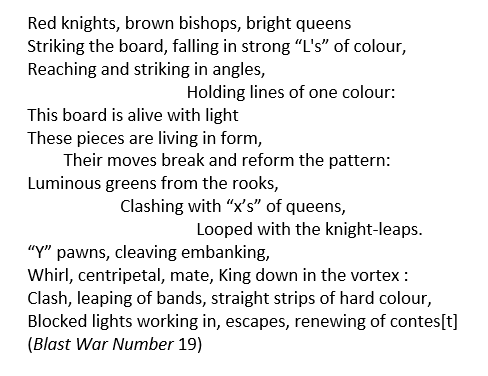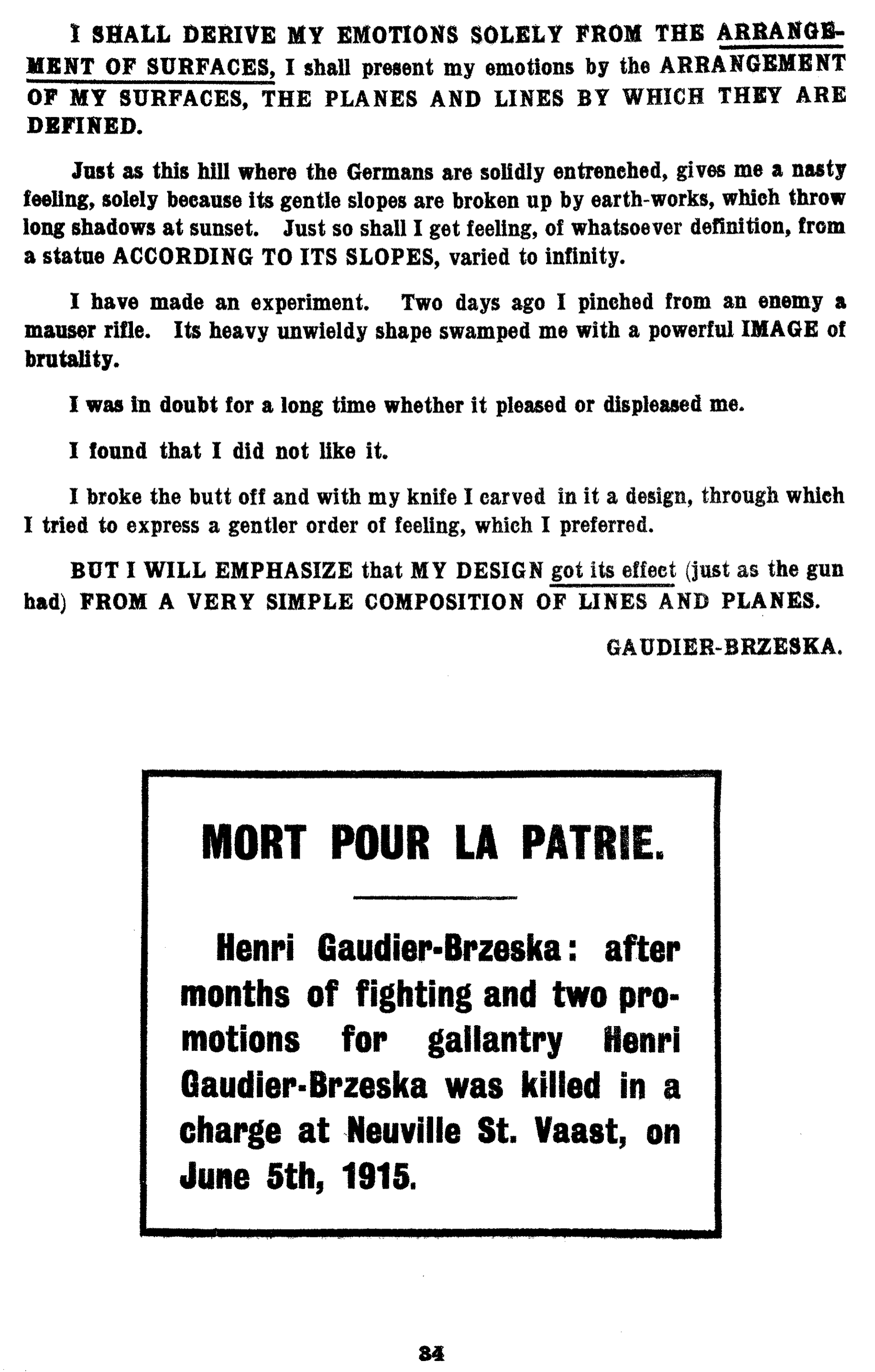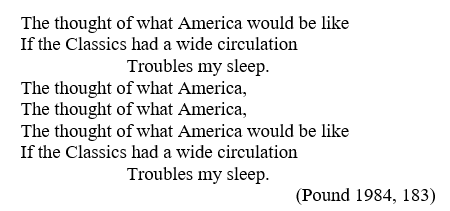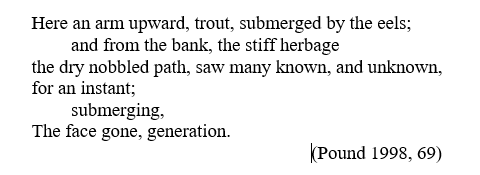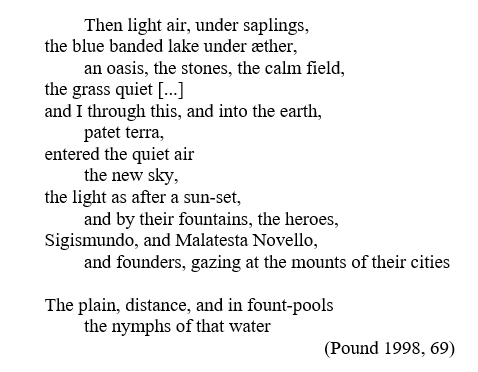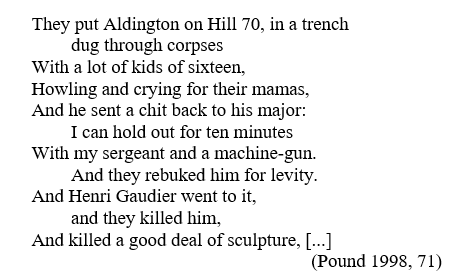CHLOÉ THOMAS
Abstract
This article will examine the occurrences of the phrase “The Wilderness of Mirrors”, from Eliot’s “Gerontion”, in a series of surprising contexts and translations. In particular, its use by CIA chief of counter-intelligence James Jesus Angleton to describe double agents will serve to explain how Eliot’s words became a commonplace item of pulp fiction and rock albums. “The Wilderness of Mirrors” is also the title chosen by the American translator of Max Frisch’s Mein Name sei Gantenbein (which translates literally as: “Let’s pretend I’m called Gantenbein”), although the novel does not mention Eliot – but it features, if not a double agent, at least a protagonist with a complex identity. The French translation of the novel is Le Désert des miroirs, that is, a translation of the English translation. Yet it does not use the most easily available French translation of Eliot, that of Pierre Leyris (“cette exubérance de miroirs”) and chooses instead a phrase that also echoes, probably on purpose, Le Désert des Tartares by Dino Buzzati. Navigating these convoluted transfers, this paper will argue that the “wilderness” at hand is not so much a “désert” as a forest of sorts.
Résumé
Cet article examinera les occurrences de l’expression « The Wilderness of Mirrors », tirée de « Gerontion » d’Eliot, dans une série de contextes et de traductions surprenantes. D’un intérêt particulier, son utilisation par le chef du contre-espionnage de la CIA, James Jesus Angleton, pour décrire les agents doubles, servira à expliquer comment les mots d’Eliot sont devenus un élément banal des romans de gare et des albums de rock. « The Wilderness of Mirrors » est également le titre choisi par le traducteur américain de Mein Name sei Gantenbein de Max Frisch (qui se traduit littéralement par : « Faisons comme si je m’appelais Gantenbein »), bien que le roman ne mentionne pas Eliot – mais il met en scène, sinon un agent double, du moins un protagoniste à l’identité complexe. La traduction française du roman est Le Désert des miroirs, c’est-à-dire une traduction de la traduction anglaise. Mais elle n’utilise pas la traduction française d’Eliot la plus facile à trouver, celle de Pierre Leyris (« cette exubérance de miroirs »), et choisit à la place une phrase qui fait également écho, probablement à dessein, au roman Le Désert des Tartares de Dino Buzzati. En naviguant dans ces transferts alambiqués, cet article soutiendra que le « wilderness » en question n’est pas tant un « désert » qu’une sorte de forêt.
——
Introduction
In 1964, Swiss author Max Frisch published the novel Mein Name sei Gantenbein, commonly regarded as one of his greatest achievements. The title, using a form of subjunctive associated with reported speech, which knows no strict English or French equivalent, translates literally as Let’s pretend my name is Gantenbein. Although difficult to summarize, the novel revolves around an unnamed narrator who, after having been left by his wife, invents a number of fictitious characters to help him account for his experience, “trying out stories as if they were clothes” [“” (Frisch, Gesammelte Werke in zeitlicher Folge , 5 22)]. Among them is Gantenbein, who is passing for blind, and Enderlin, whose name evokes der Andere, the other; the narrator connects them together through their relationship to the same woman, Lila.
The 1966 French translation of the book was published as Le Désert des miroirs (Frisch, Le Désert des miroirs), a title that, at first glance, seems to be meant as an echo to the “mirroring” theme of the novel, with its interplay of identities, at least one explicit mirror scene (when Gantenbein actually tries out clothes in a shop), and an experiment with mirroring names in an Oriental tale made up by Gantenbein for Lila, with characters named Ali and Alil. Gantenbein’s French translator was André Coeuroy. The inside cover of the Gallimard edition mentions, in a somewhat convoluted phrase, that the translation was validated by the author himself (“traduction contrôlée en collaboration avec l’auteur,” which leaves room for interpretation as to what exactly Frisch did control or collaborate on). The French title, however, stems directly, it seems, from the one that had been chosen for the English translation by Michael Bullock, which appeared in 1965, a year before the French version: The Wilderness of Mirrors (Frisch, A Wilderness of Mirrors). It was T. S. Eliot, obviously, who provided Frisch’s novel with both its English and, indirectly, French titles. Here is the passage from “Gerontion” from which it was taken, towards the end of the poem:
These with a thousand small deliberations
Protract the profit of their chilled delirium,
Excite the membrane, when the sense has cooled,
With pungent sauces, multiply variety
In a wilderness of mirrors. What will the spider do,
Suspend its operations, will the weevil
Delay? […] (Eliot, The Complete Poems and Plays 38)
Frisch, who had spent a year in the United States in 1951 on a Rockefeller grant, read English fluently and had been corresponding with Michael Bullock, but it is not known whether the title was his idea, Bullock’s or the publisher’s.[1] The very fact that a phrase from an Eliot poem was used as the title of another book seems, however, interesting per se. There does not seem to be a specifically Eliotian reference in Gantenbein. Of course, the identity-blurring theme is not without connections to Eliot’s own interest in depersonalisation, but it fits more generally in the postmodern landscape of these years. The secondary literature on Frisch makes no mention, it seems, of an Eliotian intertextuality in his work, except one paper by Melanie Rohner focused on Frisch’s writings from the 1950s and on Eliot’s plays, for which Frisch showed particular interest (Rohner). The “wilderness of mirrors,” then, seems to have been used in the English edition of Gantenbein more as a trope, a cliché, than as an explicit Eliot quotation.
Wilde Tropes
Eliot died the same year as the English translation appeared, and was already part of the international canon by then. It comes consequently as no huge surprise that elements from his poems had found their way as stock phrases. A number of bits and pieces from The Waste Land (“April is the cruellest month,” “I will show you fear in a handful of dust” or simply “Shantih shantih shantih”) or from the essays (“objective correlative” and “dissociation of sensibility”) have been repeatedly cited since their first utterance. However, they have generally not lost their connection to their primary author. The situation of “the wilderness of mirrors” is slightly different in that respect, and the Frisch translation appears to be only a by-product of a more thorough translocation process.
When one searches Google scholars for “wilderness of mirrors,” the vast majority of the results yielded are not, in fact, about Eliot. They are even less about Frisch, although this may also have to do with Michael Bullock’s translation having been reprinted in the 1980s under the more neutral title Gantenbein. Most of what comes up is about counter-intelligence. A narrower search in “Project Muse,” the database of scholarly articles on literature, also provides mostly results related to espionage. The origin of the shift appears to be quite clear: “the wilderness of mirrors” happens to be a phrase recurrently used by James Jesus Angleton, who was chief of counter-intelligence for the CIA between 1954 and 1974, to describe the angst and confusion created during the Cold War by moles and double agents. Now the phrase is quite fitting to describe Angleton’s obsession, and, even though it is once again taken out of its “Gerontion” context, its use during the Cold War can be regarded as more or less consistent with Eliot’s own, more poetic interests in the dissolution of the subject, which are also explored in Gantenbein. The phrase, then, seems to have turned trope in the postmodern context because it did fit the sceptic and relativist stance of these times. One may well believe at this stage that Angleton had come across the phrase in his high school or college days, at a time when Eliot had entered syllabi, in particular via New Criticism (for instance the influential textbook Understanding Poetry, edited by Cleanth Brooks and Robert Penn Warren, first published in 1938). But the connection runs deeper: Angleton was, in fact, a double agent of sorts.
An English major at Yale before the war, Angleton was an undergraduate poet himself, as well as the editor of the literary magazine Furioso, which published a number of Modernist writers. In that capacity, Angleton corresponded with Eliot, Pound and Cummings. He studied Empson’s Seven Types of Ambiguity and was taught most notably by Norman Holmes Pearson, the Yale academic as well as editor, advisor and agent of H.D., and Donald Gallup’s collaborator at the Yale Collection of American literature, which they helped turn into one of the major archive centers in the field, with a particular focus on Modernism. Norman Holmes Pearson was also a prominent counterintelligence agent during the Second World War. He worked at the Office of Strategic Services in London and had a number of people from the Yale English Department recruited, including Donald Gallup, Louis Martz (the Milton scholar), Richard Ellman (the Joyce biographer), and Angleton himself. Although Pearson returned to Yale and to scholarly work after the war, his death in Seoul in 1975 triggered speculation about him still working for the CIA and having been poisoned by North Korea. As for Angleton, he was confronted, while serving in London, to the infamous case of double agent Kim Philby, and remained a CIA official after the war, growing increasingly paranoid about possible KGB spies whom he saw everywhere (Lee Harvey Oswald and Kissinger, among others, were suspected by him of working for the Soviet Union).
In a 1992 New York Times article on poetry and intelligence, Eliot Weinberger writes:
Angleton, who kept reading poetry all his life, claimed in later years that he had always tried to recruit agents from the Yale English Department. He believed that those trained in the New Criticism, with its seven types of ambiguity, were particularly suited to the interpretation of intelligence data.[2]
Weinberger then proceeds to consider the possible ambiguities of a piece of intelligence.
Consider, after all, the ways a spy’s message may be read:
1) It is written by a loyal agent and its information is accurate.
2) It is written by a loyal agent but its information is only partly accurate.
3) It is written by a loyal agent but its information is entirely inaccurate.
4) It is written by a double agent and its information is completely false.
5) It is written by a double agent but its information is partly true, so that the false parts will be believed.
6) It is written by a double agent but its information is entirely true, so that the allegiance of the agent will not be discovered.
Here one may think in particular of the question of allusion and citation in Eliot’s, and their accuracy, their originality, their function as red herrings or misleading devices. Weinberger concludes:
Moreover, the message is written in code, and liable to the vagaries of translation. And it is written in a highly condensed language, whose meanings can offer varying interpretations. Like a poem, the message is only as good as its reader. Roosevelt refused to believe a report on the imminent attack on Pearl Harbor; the Federal Bureau of Investigation thought that Pound’s “Pisan Cantos” were the encoded communications of a spy. (Weinberger, “Tinker, Tailor, Poet, Spy”; republished as “James Jesus Angleton 1917-1987” in Outside Stories, 1987-1991 53–54)
It is just as easy to take “signs for wonders,” as “Gerontion” invites one to do (“Signs are taken for wonder,” when reading Eliot. The FBI did open a file on Eliot in the late 1940s, after his name came up in the socialist paper The Daily Worker (Culleton and Leick 2), as if, perhaps, his vocal conservatism made him suspect of being a crypto-communist. The complexity of The Waste Land, with its mixture of languages – at a time when translation itself, with the development of early machine translation, came to be understood as a branch of cryptography[3] – and its interweaving of quotations, would make the poem look particularly suspicious, one imagines, to the eyes of someone trained in the spotting and decoding of Cold War double-entendre. “Gerontion” is not built in the same way as The Waste Land, and certainly less prone to be read as a secret message. Yet it would definitely strike a chord in someone interested both in poetry and in ciphers: “I have lost my sight, smell, hearing, taste and touch: / How should I use it for your closer contact?” That the poem has to do with an impossibility, or at least a difficulty, to communicate, does not make of it a coded text, but one understands why it could still be read with interest by an intelligence officer.
Angleton’s use of the “wilderness of mirrors” phrase was, then, likely to have been very well informed; what he was taking up, and relatively early on, was not a trope yet, but a fragment that he read in its context, and then recycled for specific purposes. It is really the recycling that made the phrase popular and turned it into a trope, to the point that, in fact, the content and themes of Gantenbein can be regarded as more consistent with Angleton’s use of the phrase than Eliot’s. One is left to wonder whether the Frisch translation was taking its cue from “Gerontion” or directly from the CIA.
On the Google NGram of the phrase (and even though it is difficult, because of various limitations[4] – in particular the increasing proportion of scientific texts and secondary literature in the Google Books corpus – to draw any firm conclusion from it), one sees that the phrase starts getting popular in the 1970s and peaks in the late 80s. It can mean one of two things, or both at the same time: a surge in Eliot scholarship (a hypothesis which makes sense, if only because of the general growth in academic publications over the century, not to mention Eliot’s position in the world canon since at least his Nobel Prize), and/or a surge in its use in espionage context, a hypothesis that is also corroborated by its recurrence in books on the subject, notably David C. Martin’s history of the CIA in the Angleton years, first published in 1980 and successful enough to have been translated in a number of languages, French included, and to be reprinted as a paperback (Martin, Wilderness of Mirrors; KGB contre CIA ou les cruautés des miroirs). The phrase then served as a title for a number of books on counter-intelligence in the Angleton years (Evered; Seingalt; Magee; Hill). But it came to be used as well for books about spies in general, for instance a novel by Ed Cambro, in 2008, on an FBI agent plotting a nuclear attack on NYC after 9/11, or a 2012 pulp fiction novel by Ella Skye involving a blonde interior designer and, quoting from the summary provided by the publisher, a “world-weary spy” (Cambro; Skye). Ultimately, it also ended up in other romance fictions: “Through the heartwarming tale of an atypical small-town woman, Wilderness of Mirrors entices us to take ventures as a step toward some measure of self-fulfillment,” reads the presentation of Helen Baker’s 2012 novel on Amazon (Baker). Here, it becomes unclear whether the phrase was conveyed from Eliot by Angleton (and his spies), or from Frisch (and his own provincial stories of adultery and jealousy) via Angleton.
Through counter-intelligence, then, the “wilderness of mirrors” became a trope in the late 20th century, and Eliot entered pop culture through pulp fiction, but also rock albums: Wilderness of Mirrors by Waysted, in 2000, and Vigil in a Wilderness of Mirrors, by Fish, in 1990. The hyperbolic canonization of an avant-garde author entails in itself the risk of turning them into a provider of kitschy phrases. Eliot praised Ernst Robert Curtius’s 1948 Europäische Literatur und Lateinisches Mittlealter (translated by Willard Trask as European Literature and the Latin Middle Ages in 1963), which analysed the “commonplace” in Medieval rhetoric and its influence over modern European literature. The “wilderness of mirrors” seems to represent a modern European “commonplace.” Curtius, who was also a keen philologist of Modernist literature, was the author of the first German translation of The Waste Land, published in 1927 as Das Wüste Land. In the latter, it is Eliot who, with his borrowing policy, built a poem out of commonplaces. Norbert Hummelt, in his recent retranslation, provides a last twist to this mirroring of Modernism and the commonplace. Hummelt changed Curtius’s title to Das Öde Land (Eliot, Das Öde Land). “Öde”, of course, was taken from the poem itself (“öde und leer / das Meer”); and Eliot took the phrase from Wagner’s Tristan. In the poem, it is a soundbite of high-brow culture, meant to be recognized by those who share it, and haunt the same (common) places; the commonplace being, obviously, a wasteland, the poem also stages the appropriation and hollowing out of the phrase by a corrupt elite stopping in the colonnade. The text from Wagner’s opera becomes (in part) garishly sentimental. The later destiny of the “wilderness of mirrors” indeed mirrors, in a way, the distortion imposed by Eliot on quotations in The Waste Land, as the phrase is turned into a kitschy commonplace.
Deserts and Forest
It is striking that the chosen title for the French version of Gantenbein, Le Désert des miroirs, while literally based on the English translation, is not so much evocative of Eliot to a French reader, as of Dino Buzzati’s 1940 Le Désert des tartares (Tartar Steppe in English, both literal translations of the Italian Il Deserto dei Tartari), whose 1949 French edition, in Michel Arnaud’s translation, was a long-lasting success but bears no obvious connection to Frisch’s novel. Eliot is also less visible in Le Désert des miroirs because, in Pierre Leyris’s translation of “Gerontion,” there is actually no such thing as a désert:
Ces considérations et mille autres pareilles
Prolongent l’agrément de leur délire glacé,
Excitent la muqueuse, le sens ayant froidi,
De leurs sauces poivrées, multiplient les aspects
Dans une exubérance de miroirs. L’araignée,
Que fera-t-elle ? (Eliot, La Terre Vaine 45)
“Exubérance” (“exuberance,” but also “luxuriance,” “abundance”) for “wilderness” is quite surprising, to the point that one wonders whether Leyris did not, by a more or less conscious mistake, translate “wildness” instead. It may very well be that prosody dictated his choice: these lines are alexandrines, which Leyris consistently uses to translate Eliot’s iambic pentameters. Leyris actually has a tendency to “over-alexandrinize,” to translate in alexandrines lines that are not regular in English, and it is the case with the “wilderness of mirrors” line – the only discrepancy in Leyris’s French, hereBut even if one considers that Leyris wanted twelve feet and that it determined his choice of words, vaste désert, for instance, would actually have worked better, both semantically and prosodically. Maybe Leyris did not like the idea of désert for wilderness because, to contemporary French readers, the word rather brings to mind an arid, empty, sandy landscape. Yet désert and “wilderness” are both canonical translations for ἔρημον in the Bible, for instance in Matthew 4:1:
Koine: τοτε ο ιησους ανηχθη εις την ερημον υπο του πνευματος πειρασθηναι υπο του διαβολου.
King James: Then was Jesus led up of the Spirit into the wilderness to be tempted of the devil.[5]
Vulgate : Tunc Jesus ductus est in desertum a Spiritu, ut tentaretur a diabolo.
Louis Segond: Alors Jésus fut emmené par l’Esprit dans le désert, pour être tenté par le diable.
AELF : Alors Jésus fut conduit au désert par l’Esprit pour être tenté par le diable.
Chateaubriand, in Le Génie du Christianisme (The Genius of Christianity), also uses désert to describe the American wilderness, which, as a typological enactment of the Biblical, is necessarily among the connotations of Eliot’s “wilderness of mirrors:”
Un soir je m’étais égaré dans une forêt, à quelque distance de la cataracte de Niagara ; bientôt je vis le jour s’éteindre autour de moi, et je goûtai, dans toute sa solitude, le beau spectacle d’une nuit dans les déserts du Nouveau Monde.
…
Auprès tout auroit été silence et repos sans la chute de quelques feuilles, le passage d’un vent subit, le gémissement de la hulotte ; au loin, par intervalles, on entendoit les sourds mugissements de la cataracte du Niagara, qui, dans le calme de la nuit, se prolongeoient de désert en désert et expiroient à travers les forêts solitaires. (Chateaubriand, Génie Du Christianisme 114, 115 emphasis mine)[6]
Chateaubriand’s use of the word désert is not exactly consistent with our modern vision of it, which is of something “öde und leer,” to quote from Wagner as quoted by Eliot: something desolate and empty. His déserts are, rather, close to forests: either assimilated to them, as in the first paragraph quoted above, or geographically and physically close, as in the second. Leyris’s “exubérance”, a word that can be associated to a jungle, to luscious vegetation, is congruous with that kind of déserts. And when Eva Hesse translated “Gerontion” for the Suhrkamp edition of Eliot’ Collected Poems [Gesammelte Gedichte], she wrote:
Das alles, in einem tausendfachen Hin und Her,
Vermehrt den Zuwachs dieses kalten Kollers,
Kitzelt, da das Gefühl erstarb, den Hautnerv
Mit scharfen Würzen, ver-x-facht die Vielfalt
In einem wilden Wald von Spiegeln. Wird die Spinne ihr Werk
In der Schwebe lassen? […] (Eliot, Gesammelte Gedichte emphasis mine)
“In einem wilden Wald”: literally, “in a wild forest”. The alliteration, suggestive even of a possible common root between wild und Wald, works beautifully in German. And that understanding of “wilderness” suddenly makes it more germane to an Alpine author such as Max Frisch. But it is not the canonical correspondence to the Biblical ἔρημον in the Luther Bible:
Luther Bible: Da ward Jesus vom Geist in die Wüste geführt, auf daß er von dem Teufel versucht würde. (emphasis mine)
“In die Wüste”: in the desert. “Wüste”, of course, rings another bell – as it should: it is the word that became “waste” in English (“Waste, Adj.”).
Conclusion: The Waste Land as a translator’s “wilderness of mirrors”
“The wilderness of mirrors” appears in one of Eliot’s early poems, but it seems to foreshadow the long poem to come by anticipating the luscious forest (of allusions, languages, broken mirrors) that the waste land actually is, as much as it is a desert. Eva Hesse, when she retranslated The Waste Land for Suhrkamp, kept Curtius’s title for it, Das Wüste Land. Translators of Eliot, and of The Waste Land in particular, must first spy out for allusions, quotations and references; their first mission, should they accept it, is to decipher what the palimpsest (a double-agent in itself) both hides and points to, and to account for the tracks, right or wrong, it opens. “There is a book to be written on poetry and espionage” (Weinberger, Outside Stories, 1987-1991 54), wrote Weinberger in his NYT article. A number of such books were indeed written, especially regarding Modernism (Culleton and Leick; Piette; Redding; Shaw especially chapter 1). They don’t make much of translators. But it is on the condition of their skilled self-effacement that these remain, perhaps, the most proficient in the art of literary espionage. Working a century after the deed, re-translators of Eliot have to navigate not only the allusions that the author himself meant to put in his text, but also the evolution of the connotations associated with words, and the fact that Eliot’s “own” (whatever “own” means) phrases may have been given a new twist by having been used in different contexts, may even have turned into clichés and sound like strange allusions to things that appeared later than the text itself. Eliot uses tropes but also builds them; he writes originality out of commonplace and his originality turns commonplace. Translators, then, looking for the right balance between the hackneyed and the hapax, are as ever – and to use a beautiful and singular phrase, a trope, or perhaps a cliché – walking in forest dark.
Notes
[1] Michael Bullock’s papers are preserved at the University of British Columbia and include his correspondence with Frisch from 1965 onwards, but with only one letter from 1965 by Frisch in which he discusses a few translation points, the title not being among them. My gratitude to Erwin Wodarczak, an archivist at UBC, who took the time to find and summarize the letter for me.
[2] William R. Johnson, who worked with Angleton, had a very similar discourse, noting that English graduates were taught “to look for multiple meanings, to examine the assumption hidden in words and phrases, and to grasp the whole structure of a poem or a play, not just the superficial plot or statement. So the multiple meanings, the hidden assumptions, and the larger pattern of CI cases were grist for their mill” (Johnson 9–10). Lytle Shaw retrieved and discusses these words (Shaw 58), and also notes that the connection between literature and counter-intelligence in Angleton’s work is explored in great detail in James Holzman’s biography (Holzman).
[3] Warren Weaver, one of the pioneers of the field at MIT, wrote in a letter to his colleague Norbert Wiener, in 1947: “One naturally wonders if the problem of translation could conceivably be treated as a problem in cryptography. When I look at an article in Russian, I say: ‘This is really written in English, but it has been coded in some strange symbols. I will now proceed to decode” (“Warren Weaver”).
[4] (See for instance Pechenick et al.)
[5] A few modern English translations of this verse actually choose “desert” over “wilderness”, for instance the 2011 New American Bible, Revised Edition.
[6] The 1875 English translation by Charles White chooses “desert” : “I had wandered one evening in the woods, at some distance from the cataract of Niagara, when soon the last glimmering of daylight disappeared, and I enjoyed, in all its loneliness, the beauteous prospect of night amid the deserts of the New World. (…) Near me, all was silence and repose, save the fall of some leaf, the transient rustling of a sudden breath of wind, or the hooting of the owl ; but at a distance was heard, at intervals, the solemn roar of the Falls of Niagara, which, in the stillness of the night, was prolonged from desert to desert, and died away among the solitary forests.” François-René Chateaubriand, The Genius of Christianity; or, The Spirit and Beauty of the Christian Religion, trans. Charles Ignatius White (Baltimore, Md.: J. Murphy, 1875), 173, http://archive.org/details/geniuschristiani00chatuoft.
Works cited
Baker, Helen. Wilderness of Mirrors. Dorrance publishing, 2012.
Cambro, Ed. A Wilderness of Mirrors. Strategic Book Publishing & Rights Agency, LLC, 2008.
Chateaubriand, François-René de. Génie Du Christianisme. Garnier Frères, 1828.
—. The Genius of Christianity ; or, The Spirit and Beauty of the Christian Religion. Translated by Charles Ignatius White, Baltimore, Md. : J. Murphy, 1875. Internet Archive, http://archive.org/details/geniuschristiani00chatuoft.
Culleton, Claire A., and Karen Leick, editors. Modernism on File : Writers, Artists and the FBI, 1920-1950. Palgrave Macmillan, 2008.
Eliot, Thomas Stearns. Das Öde Land. Translated by Norbert Hummelt, Suhrkamp Verlag, 2008.
—. Gesammelte Gedichte: 1909 – 1962. Translated by Eva Hesse, Suhrkamp, 1972.
—. La Terre Vaine : Et Autres Poèmes. Translated by Pierre Leyris, Éd. bilingue, Éd. du Seuil, 2006.
—. The Complete Poems and Plays. Faber and Faber, 1969.
Evered, Charles. Wilderness of Mirrors. Broadway Play Publishing, Incorporated, 2004.
Frisch, Max. A Wilderness of Mirrors. Translated by Michael Bullock, Methuen & Co., 1965.
—. Gesammelte Werke in zeitlicher Folge , 5 : 1964-1967. Edited by Hans Mayer, Suhrkamp, 1976.
—. Le Désert des miroirs. Translated by André Coeuroy, Gallimard, 1966.
Hill, Gary. The Other Oswald: A Wilderness of Mirrors. Trine Day, 2020.
Holzman, Michael. James Jesus Angleton, the CIA, and the Craft of Counterintelligence. University of Massachusetts press, 2009.
Johnson, William R. Thwarting Enemies at Home and Abroad: How to Be a Counterintelligence Officer. Georgetown University Press, 2009.
Magee, Aden. The Cold War Wilderness of Mirrors: Counterintelligence and the U.S. and Soviet Military Liaison Missions 1947–1990. 1st edition, Casemate, 2021.
Martin, David C. KGB contre CIA ou les cruautés des miroirs. Translated by Denis Authier, Presses de la renaissance, 1981.
—. Wilderness of Mirrors: Intrigue, Deception, and the Secrets That Destroyed Two of the Cold War’s Most Important Agents. Harper Collins, 1980.
Pechenick, Eitan Adam, et al. “Characterizing the Google Books Corpus: Strong Limits to Inferences of Socio-Cultural and Linguistic Evolution.” PLoS ONE, vol. 10, no. 10, Oct. 2015, p. e0137041. PubMed Central, https://doi.org/10.1371/journal.pone.0137041.
Piette, Adam. The Literary Cold War, 1945 to Vietnam. Edinburgh University Press, 2009.
Redding, Arthur F. Turncoats, Traitors, and Fellow Travelers : Culture and Politics of the Early Cold War. University press of Mississippi, 2008.
Rohner, Melanie. “Ein ‘Cocktail […] von Eliot Gemixt’. Intertextuelle Bezüge Zu T. S. Eliot.” Max Frischs Werk Der Fünfziger Jahre, Actes Du Colloque International: L’œuvre de Max Frisch Dans Le Contexte de La Littérature Européenne de Son Temps, Université de Haute-Alsace, Mulhouse, 11.5.2011., edited by Régine Battiston and Margit Unser, Königshausen & Neumann, 2012. boris.unibe.ch, https://boris.unibe.ch/13711/.
Seingalt, Benjamin de. The Wilderness of Mirrors: Three Decades of Deception by Kim Philby. Kindle Editions, 2017.
Shaw, Lytle. Narrowcast : Poetry and Audio Research. Stanford university press, 2018.
Skye, Ella. Wilderness of Mirrors. 1st edition, Ella Skye, 2012.
“Warren Weaver.” Wikipedia, 12 Sept. 2023. Wikipedia, https://en.wikipedia.org/w/index.php?title=Warren_Weaver&oldid=1175127956.
“Waste, Adj.” OED Online, Oxford University Press. Oxford English Dictionary, https://www.oed.com/view/Entry/226028. Accessed 18 Jan. 2023.
Weinberger, Eliot. Outside Stories, 1987-1991. New Directions, 1992.
—. “Tinker, Tailor, Poet, Spy: Tales of Literary Espionage.” The New York Times, 4 Oct. 1992. NYTimes.com, https://www.nytimes.com/1992/10/04/books/tinker-tailor-poet-spy-tales-of-literary-espionage.html.
Chloé Thomas is Assistant Professor of American Literature and Translation at the University of Angers, France. Her latest book, Les Excentrés: poètes modernistes américains, on the first generation of Modernist poets (Eliot, Stein, Moore, H.D., Pound, Williams, Stevens…) was published in 2021 with CNRS éditions. She is also a translator from English and German.

